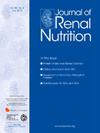慢性肾脏病早期近端肾小管液磷酸盐浓度估计值和肾小管损伤生物标志物。
IF 3.2
3区 医学
Q2 NUTRITION & DIETETICS
引用次数: 0
摘要
简介血清成纤维细胞生长因子 23(FGF23)水平升高会导致近端肾小管液磷酸盐浓度升高,从而导致慢性肾病(CKD)小鼠模型的肾小管损伤。然而,很少有人体研究支持这一概念。本研究旨在探讨肾功能轻度衰退的中老年人群中估计的近端肾小管液磷酸盐浓度(ePTFp)、血清 FGF23 水平和肾小管损伤生物标志物之间的关联:这项横断面研究包括 218 名年龄≥45 岁、CKD 分期为 G2-G4 的参与者。研究人员在早晨空腹状态下进行了人体测量、血液化验、尿液生物标记物定点检测、肾脏超声波检查、心血管评估、吸烟状况和药物使用情况。使用血清肌酐、尿磷酸盐和肌酐浓度计算 ePTFp。结果:ePTFp、血清 FGF23、尿液 β2-微球蛋白和尿液 L-FABP 水平随着 CKD 分期(G2、G3 和 G4 期)的进展而增加。然而,血清和尿液中的磷酸盐浓度在不同的 CKD 阶段具有可比性。单变量分析显示,与相应的血清和尿磷酸盐浓度相比,ePTFp 与血清 FGF23、尿β2-微球蛋白和尿 L-FABP 水平的相关性更强。多变量分析表明,ePTFp的增加与血清FGF23和尿β2-微球蛋白水平的升高独立相关,即使在调整了潜在的协变量(包括估计肾小球滤过率和尿白蛋白-肌酐比值)之后也是如此:我们的研究结果与小鼠模型的概念一致,表明在慢性肾功能衰竭的早期阶段,ePTFp的增加与血清FGF23水平的增加和肾小管损伤有关。本文章由计算机程序翻译,如有差异,请以英文原文为准。
Estimated Proximal Tubule Fluid Phosphate Concentration and Renal Tubular Damage Biomarkers in Early Stages of Chronic Kidney Disease
Objective
An increase in proximal tubule fluid phosphate concentration is caused by increased serum fibroblast growth factor-23 (FGF23) levels, which resulted in renal tubular damage in a mouse model of chronic kidney disease (CKD). However, few human studies have supported this concept. This study aimed to explore the association among estimated proximal tubule fluid phosphate concentration (ePTFp), serum FGF23 levels, and renal tubular damage biomarkers in middle-aged and older populations with mild decline in renal function.
Methods
This cross-sectional study included 218 participants aged ≥45 with CKD stages G2-G4. Anthropometric measurements, blood tests, spot urine biomarkers, renal ultrasonography, cardiovascular assessment, smoking status, and medication usage were obtained in the morning in fasted states. The ePTFp was calculated using serum creatinine, urine phosphate, and creatinine concentrations. Urinary β2-microglobulin (β2-MG) and liver-type fatty acid–binding protein (L-FABP) levels were evaluated to assess renal tubular damage.
Results
PTFp, serum FGF23, urinary β2-MG, and urinary L-FABP levels increased with CKD stage progression (stages G2, G3, and G4). However, serum and urine phosphate concentrations were comparable across the CKD stages. Univariate analysis revealed a stronger correlation of ePTFp with serum FGF23, urinary β2-MG, and urinary L-FABP levels than with the corresponding serum and urine phosphate concentrations. Multivariate analyses demonstrated that increased ePTFp was independently associated with elevated serum FGF23 and urinary β2-MG levels, even after adjusting for potential covariates, including the estimated glomerular filtration rate and urinary albumin-to-creatinine ratio.
Conclusions
Our results are consistent with the concept in mouse model and suggest that increased ePTFp are associated with increased serum FGF23 levels and renal tubular damage during the early stages of CKD.
求助全文
通过发布文献求助,成功后即可免费获取论文全文。
去求助
来源期刊

Journal of Renal Nutrition
医学-泌尿学与肾脏学
CiteScore
5.70
自引率
12.50%
发文量
146
审稿时长
6.7 weeks
期刊介绍:
The Journal of Renal Nutrition is devoted exclusively to renal nutrition science and renal dietetics. Its content is appropriate for nutritionists, physicians and researchers working in nephrology. Each issue contains a state-of-the-art review, original research, articles on the clinical management and education of patients, a current literature review, and nutritional analysis of food products that have clinical relevance.
 求助内容:
求助内容: 应助结果提醒方式:
应助结果提醒方式:


